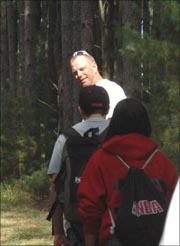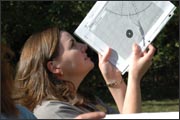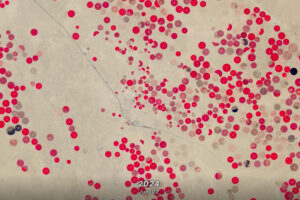
An educational satellite validation field campaign called “Bridging the GAPS from Space: How to validate NASA Satellite Data in the Field” was recently conducted at the Pocono Environmental Education Center (PEEC) in Dingmans Ferry, PA, on the grounds of the Delaware Water Gap National Recreation Area (DEWA). The field campaign was jointly sponsored by the Landsat Program Science Office (LPSO), the Landsat Education and Public Outreach program, the National Park Service (NPS), the GLOBE Program and the Northeastern and Colonial Intermediate Units from the State of Pennsylvania. The campaign was attended by over 130 participants, including middle and high school science, math, and geography teachers and their students from eleven local school districts, scientists from LPSO, staff from two national parks and the NPS Inventory and Program, as well as NOAA. Attendees also included the Park Superintendent and Chief of Natural Resources Division of DEWA, the Outreach Coordinator for the Environmental Institute at Lackawanna College, undergraduate students from the University of Maryland, four television stations and multiple members of the media who interviewed organizers, trainers and participants. GLOBE Master Trainers Jessica Robin, Frank Niepold and John McLaughlin, both with NOAA, assisted with the training and field campaign.
The objective of the campaign was to train the teachers and students how to validate tree cover and impervious cover Landsat data sets for the Upper Delaware River Basin, which are being developed through Eric Brown de Colstoun’s NASA-funded New Investigator Program project.

The project aims to use Landsat to measure land cover change and urban growth in the Upper Delaware Basin from 1984 to the present and to study the effect of these changes on local National Parks. Limited biometric data to support ICESAT satellite land data sets were also collected at selected sites. Participants received a brief presentation on the research component of the project and a short training in the GLOBE GPS and Land Cover/Biology field protocols. Then in groups of four to eight students and teachers they went to their assigned sites in DEWA Park to make field measurements. Participants also measured two principal sites at PEEC to assess the variability between each group’s measurements. This research/educational partnership between the Principal Investigator (Eric Brown de Colstoun), the NPS, the PA Intermediate Units and area students and educators is one that clearly benefits the development and validation of the research. It also provides the compelling story line for a wide variety of educational activities using NASA data and GLOBE protocols, all within the spectacular setting of our National Parks.
Summary courtesy of Jessica Robin.
+ Related article from the Pocono Record (external link)
+ Visit the GLOBE website

Undamming the Klamath
Between October 2023 and October 2024, the four dams of the Klamath Hydroelectric Project were taken down, opening more than 400 miles of salmon habitat.





